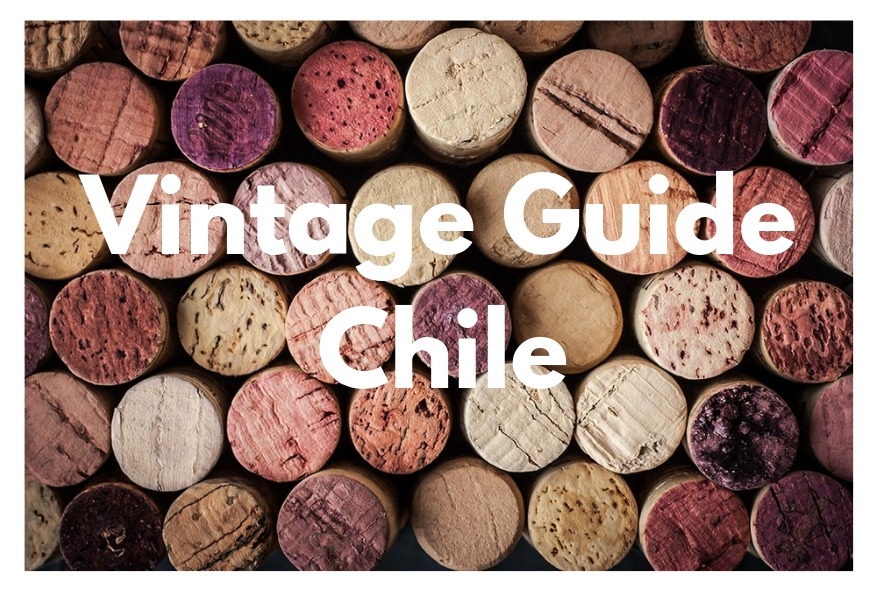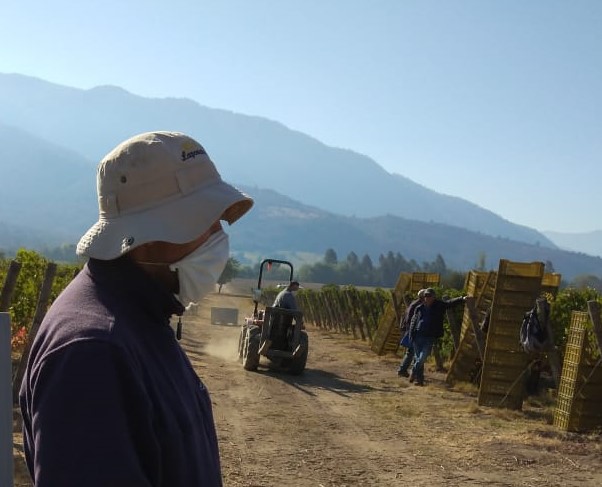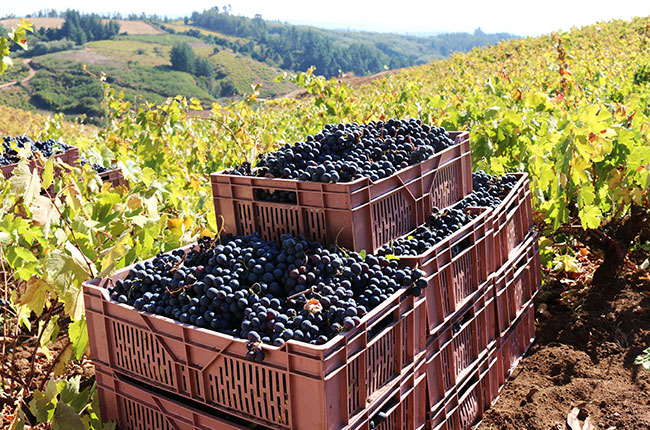The ultimate vintage guide for Chile: Chile harvest reports from 1996 to 2022
What’s in a vintage? Quite a lot actually. In our Chile vintage guide we don’t just look at the country overall but try to take different regions individually. Chile is an expansive and diverse wine country and so one Chile vintage chart or score doesn’t work across the board. Each region and variety varies in each vintage which is why we don’t rate vintages with points or scores. Winemakers and viticulturalists also manage the vintage accordingly – a bad vintage per se can still produce an excellent wine, depending on the vineyard management.
Our Chilean vintage guide takes into account winemaker interviews from the major winemaking regions of Chile to give you a complete understanding of what to expect from the different harvest reports in Chile.
Chile vintage guide
Vintage variation in Chile is less extreme than most wine regions and as most vineyards are irrigated, vintage variation effects are limited. The greatest actors in changing the vintage in Chile are:
- rainfall: too little is a greater risk than too much. Drought is a serious issue in most of the Central Valley and coastal regions, especially as the majority of Chile’s modern vineyards are irrigated. Too much rainfall affects the harvest time and concentration of grapes, however, fungal diseases are rarely a significant problem.
- heat and sunshine: Chile’s wine regions are almost all abundant with plentiful sunshine which is what makes Chile’s bright fruit aromas in wine so prevalent. However, heat spikes can cause early maturation and acids to drop.
- frost: can be a significant issue in lowering yields, especially in the more marginal wine regions on the coast and mountains.
The Chile vintage guide below is designed to give you an insight on Chile’s different vintages and what you can expect in general from the wines of that vintage. There are, of course, exceptions to the rule, and Chile’s vintages are growing increasingly varied.
Quick reference guide to wine harvests in Chile
2022: Excellent quality, comparable to 2018
2021: Cool, wet vintage but promising quality
2020: Warm, early vintage
2019: Concentrated drought vintage
2018: Excellent, star quality vintage
2017: Hot vintage & forest fires
2016: Cool vintage with lower yields
2015: Warm vintage & riper styles
2014: Massive frost damage, but complex wines
2013: Cool vintage with freshness
2012: Warm vintage with generous wines
2011: Cool and elegant vintage
2010: Cool vintage, affected by the earthquake
Want to know more about the
wine regions of Chile?
ORDER YOUR COPY of The South America Wine Guide now!
E-book AVAILABLE ONLINE too.
Chile Vintage 2022 guide
Chile harvest report 2022: Excellent quality although small quantity in drought vintage
The 2022 vintage started out well in winter 2021 as decent rainfall looked to offer some relief from the prolonged drought in Chile. However in Spring, another drought period hit and any dry-farmed vineyards were particularly stressed with a lack of water. As a result, the ‘secano interior’ regions of Itata and Maule were most severely hit by drop of yields, although hardier old vines suffered fewer losses.
The climate conditions however offered moderate temperatures and good diurnal range, leading to many comparisons with the stellar 2018 vintage. Reds in particular excelled, and whites in the cooler coastal regions.
Expect: Lower volumes but top quality, especially in the mountain reds. Freshness across the board.
Best for: Elegant and ageworthy reds
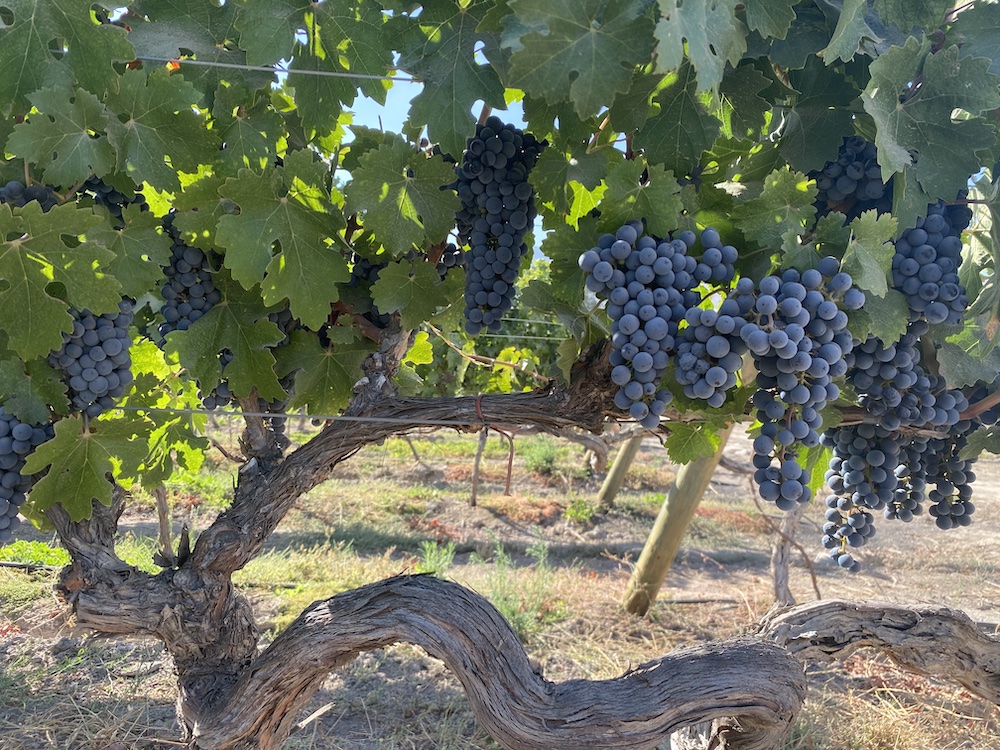
Coastal Chile Vintage Report 2022
Despite the dry summer, the buffer of the Pacific Ocean offered some relief to coastal producers and Chile’s coastal regions are reporting a very promising vintage with fresh and focused wines from a slightly cooler year than average.
Limarí in particular has fared well with excellent quality across the board, and especially for the cool climate varieties of Chardonnay, Pinot Noir and Sauvignon Blanc.
Andes Vintage Report 2022: Aconcagua, Maipo, Cachapoal, Colchagua
The mountainous wine regions in the Andes are reporting an excellent vintage with somewhat cooler conditions which led to concentrated and fresh reds, with Cabernet Sauvignon being a particularly stand out variety this year. Many of the winemakers in Maipo are comparing the 2022 vintage to the stellar 2018 vintage in terms of quality.
Having access to irrigation water was, however, essential as there was very little rainfall in the season.
Entrecordilleras Vintage Report 2022: Maipo, Colchagua, Curico
Although the drought significantly impacted the dry inner valleys, a significant thermal amplitude between day and night during the maturation season gave good character to the wines. Yields were lower than usual although the quality was high with reds performing particularly well, and of note Carmenere and Cabernet Sauvignon.
I’m particularly excited about the red wines in 2022, and the potential for beautifully balanced wines that will offer fresh acidity and rich fruit flavours.
Pilar Diaz, winemaker at Volcanes de Chile
Southern Chile Vintage Report 2022: Maule, Itata & Bio Bio
The drought notably impacted the southern dry-farmed regions of Maule, Itata and Bio Bio which largely rely on rainfall. However, the saving grace was largely the age of many of the vineyards here, with the deep root systems of the old vines managing to steer through the dry season while still being fruitful. There was a lower yield across the board, which enabled good ripening in the vineyards and led to a high quality vintage even though the quantity was down.
We are sure this is going to be a great vintage, where the balance between concentration and acidity will be a defining characteristic.
Christian Sepulvida, winemaker at Bouchon Family Wines
Further south in the region of Malleco, it was a slightly warmer vintage than normal – offering good ripeness to this cool climate.
Chile Vintage 2021 guide
Chile harvest report 2021: A cooler, wetter vintage with small yields, but promising quality
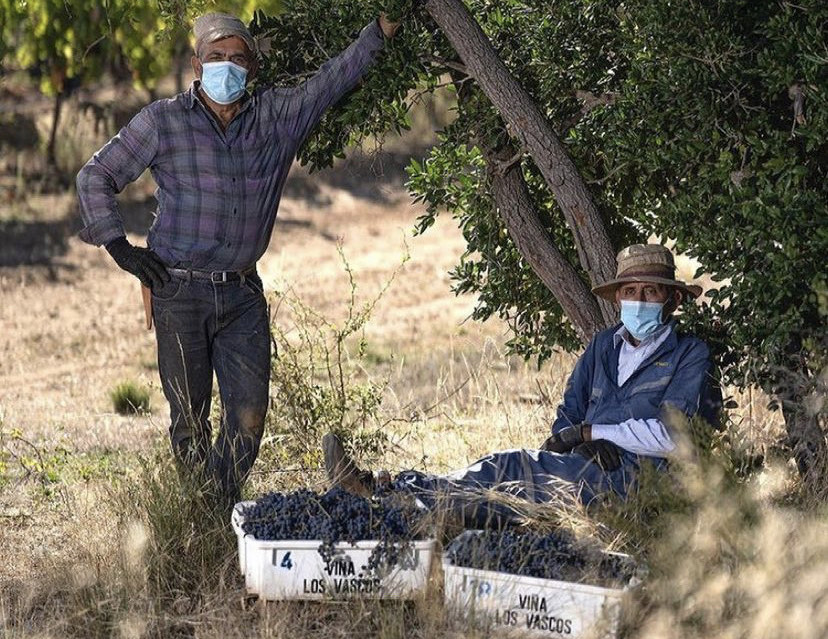
Rainfall over the winter of 2020 was a much-needed blessing for Chile’s wine regions which had been experiencing a ten-year mega drought and set the vintage 2021 up for a better start. Overall, Chile’s 2021 vintage was a much cooler one with reduced yields but promising quality and good concentration.
Some summer rain meant that vineyard management was key and although Chile was still partially in lockdown with Covid restrictions, the wine industry were given key worker exceptions. Worker availability however, was at all time low and many wineries struggled with shortages.
Expect: Good concentration with fresher, lower alcohol red wines; lighter white wines
Best for: Late harvesting red wines; Premium white and red wines. (Bulk production suffered with the cooler, wetter vintage, especially in white wines)
Coastal vintage report 2021 Chile
In Limarí, conditions were dry but picking was almost two weeks later than normal due to the cooler conditions although quality is promising. “We can compare this vintage to the cooler 2018 vintage, and the wines that are already fermented and finished are looking fantastic — the balance and the acidity are marvellous,” says Tabalí winemaker Felipe Müller.
Frost again hit Casablanca and San Antonio this year, with some producers losing a quarter of yield. And some summer rainfall meant growers had to be particularly attentive in the vineyard. “This year the coastal areas have experienced a very cool climate vintage!” says Eduardo Jordan of Miguel Torres, who make Sauvignon Blanc in Casablanca. “Ripeness has been very slow, and you had to take care with the botrytis risk but the result is good. The wines are lower in alcohol this year too.”
Andes Vintage Report 2021: Aconcagua, Maipo, Cachapoal, Colchagua
Across the Andes regions in Aconcagua, Maipo, Cachapoal and Colchagua, the vintage was much cooler although rainfall was less of an issue as a warmer and drier March helped ripeness. Although many winemakers were picking at least a month later than in 2020.
“I’m very optimistic about the quality this year, we have very good acidity,” explains Viña Carmen winemaker Emily Faulconer. “This year we have a very different balance – the wines are very fresh with lower alcohol. I think this is going to be a very good vintage and we have very interesting profiles of wine, it reminds me of 2018 in terms of quality and style.
Entrecordilleras Vintage Report 2021: Maipo, Colchagua, Curico
Rainfall complicated some of the white grapes harvested in the Entrecordilleras regions ranging from between 50mm and even 110 mm in January, and most winemakers picked relatively early in order to avoid any botrytis setting in. Red wines were however less impacted and a cool February followed by moderate temperatures in March and April led to ripe fruit and tannins with moderate potential alcohol and fresh acidity.
Vintage Report 2021: Maule, Itata & Bio Bio
The dry-farmed regions of southern Chile were rewarded with the first good winter rainfall in over a decade and so yields were improved in 2021. Moderate temperatures and a cool vintage also led to wines of finesse with a slow, balanced maturation.
Read the full Chile vintage 2021 report online, with more detailed regional guides.
Chile Vintage 2020 guide
Chile harvest report 2020: A fast and furious vintage
Chile’s vintage 2020 will be one that winemakers will never forget. Not only because it was one of the earliest vintages in recent history but also because it was the first to have an international pandemic in the mix making working situations extremely challenging with lockdowns and restriction of movement.
A long drought with a warm winter and hot summer meant that in most of Chile’s wine regions the vintage came a couple of weeks up to over a month early, and the key was to pick early enough to retain acidity and character. This was particularly a challenge as many grape varieties ripened together and lockdowns and restriction of movement and social proximity made a 24-hour harvest and work in the winery and challenge. A drop in yield (by around 20% on average) was however perhaps a blessing in disguise and many winemakers are reporting good results when they were able to harvest on time.
Expect: Smaller production, bright rich fruit notes
Best for: Small production wines and cooler wine regions
Coastal vintage report Chile 2020
The cooler coastal regions were naturally more buffered from the hot temperatures and are reporting quite a good vintage, albeit with smaller yields. The earlier harvest dates (before the worst of the national lockdowns) were also beneficial: “The quality of the 2020 vintage is excellent in all varieties in Limarí, especially as we are so close to the coast that we have a very stable climate in terms of temperatures but also because we typically harvest earlier,” explains Felipe Müller of Viña Tabalí. Our earlier harvest has allowed us to produce wines of great quality: mineral, fresh, with tension and potential to age.”
Casablanca and San Antonio were largely affected by late spring frosts with some producers reporting up to 30% losses, and this also led to a lower yield and much earlier harvest.
Harvest report Maipo, Cachapoal, Colchagua & Curico 2020
The 2020 harvest in Maipo, Cachapoal and Colchagua was an early, hot and dry vintage, which in some cases came 2 – 3 weeks earlier. The restricted water access also meant that there was a lower yield across the board, with an average 20% less production but 35% in some cases. However those that harvested in time seem to be quite pleased by the results:
“In Alto Jahuel in Maipo, I’ve seen excellent results for our Cabernet Sauvignon — with great concentration and where the stressful conditions permitted us to harvest ripe but fresh fruit,” explains Emily Faulconer of Viña Carmen, speaking about their main vineyard. “For me we have good balance between moderate alcohol (especially because of our earlier harvests) and very good acidity.”
Harvest report Maule, Itata & Bio Bio 2020
The dry-farmed wine regions suffered with the lack of rain and prolonged drought conditions. Flowering came early and frost was an issue in Maule and Itata with some losses of up to 20% reported. Low rainfall also meant that yields were low, although the grapes are concentrated.
Read the full Chile Vintage 2020 report online.
Chile Vintage guide 2019
Chile harvest report 2019: A drought season dropped yields but aided concentration
A very dry start to the season, with one of the driest winters in the last 20 years, caused significant water deficiency across Chile’s Central Valleys and dry-farming regions of Maule and Itata.
A cool spring meant that budburst was slightly delayed, by about 10 days in general. Heat spikes in the Summer, in February, accelerated maturation and caused dehydration in vineyards which were particularly low on water reserves (especially dry-farmed vineyards). However cool nights during the Autumn meant that thermal amplitude allowed for the preservation of some acidity, deep colours and rich body and mouthfeel.
Expect: A mixed bag, depending on the vineyard location and microclimate.
Best for: Cooler sites (higher altitude, coastal) with greater water availability; premium wines; full-bodied reds.
Worst for: Large-production wines, especially white wines.
Overall commentary on 2019 vintage
“In the summer we saw peaks of very high temperatures in which the accumulation of sugars was very quick, especially in the ‘Entre Cordilleras’ Central Valley regions,” explains Matias Cruzat, winemaker at Viña San Pedro. “These temperature peaks did cause dehydration in some varieties. Broadly speaking red wines in general are very good colour with structure and volume.”
The impact of lower rainfall compounded with the temperature spikes to lower the yield and cause some dehydration in grapes: “In the 2019 vintage we continue to see global warming effects, especially in the [decreasing] rainfall,” says Miguel Torres winemaker Eduardo Jordan. “We had 50 to 60% less rainfall in some areas of the Maule.”
“In general, I consider 2019 a very good year: white wines are elegant, with rich mouthfeel and a slightly lower acidity and less herbal character than 2018; red wines are slightly more alcoholic than 2018 but less than a normal year. While it is true that 2018 produced wines of greater fineness and tension, this year the 2019 wines have excellent mouthfeel with more volume, more weight and a better phenolic maturity.”
Coastal vintage report Chile 2019:
A water deficit caused a drop in yields in many of Chile’s coastal areas:
“In the Casablanca area there are generally lows of up to 30% less Sauvignon Blanc this year. The coastal drylands further south were also heavily effected in yields, especially in red wines with up to a 30% decrease in yields.”
Eduardo Jordan, winemaker Miguel Torres
Although the yields were lower, the coastal regions, including Casablanca, San Antonio and Limari, were somewhat protected by their coastal position from suffering the brunt of the heat waves:
“Chile’s coastal regions always have a buffer from these hotter years, where the peaks of temperature are kept lower with foggy starts to the day.”
Matias Cruzat, winemaker Viña San Pedro
Harvest report 2019 Maipo: Lower yields and high temperatures cause variability across different regions
“We started off harvesting our Syrah during the second week of April and on the third week we moved on to the Cabernet Sauvignon; both of which are well ripened and balanced in terms of sweetness and acidity. We thought that we were going to have a late harvest, but the summer heat brought it forward. As our vines are at the foot of the high mountains, they are protected from the heat; unlike other areas of Maipo where there were problems with the colour, small seeds and dehydration, which was perhaps also caused by a lack of water.”
Felipe de Solminihac, Viña Aquitania
Harvest report 2019 Curicó: Drought year with heat spikes, but a more balanced Autumn revived hope
Curicó received up to 57% less rainfall than usual, causing a water deficit for many producers.
“Summer was without major problems but in the first two weeks of February, maximum temperatures reached 37°C in Curicó. This atypical heat wave produced a lot of stress in the plants, especially in the Secano vineyards, which had little soil moisture, which had us with alarms on for a while. These higher temperatures of February generated that the rate of gain of sugars accelerated especially in those grapes that is harvested at the beginning of March.”
Eduardo Jordan, winemaker Miguel Torres
Harvest report 2019 Maule: A dry season lowered yields
With almost half the usual rainfall, drought was an issue for Maule and the other dry-farmed wine regions of Chile this year. Heat spikes reached up to 40°C in February causing some dehydration in the dry-farmed vineyards.
“This year was an average year in Maule; we started harvesting during the last week of February and we finished during the last week of April. The spring in 2018 was quite chilly and there was some rain, but overall, the rainfall this year was 25% lower than the average over the last 10 years. This really affects our dry-farmed vineyards because in general, we have had normal to low yields. Our dry-farmed vineyards had a 20% lower yield than normal.”
“The decrease in yield is largely due to the weight of the bunch, rather than the quantity of bunches of grapes. This means that the wines this year are more concentrated because the ratio of pulp to skin increased. In general, I think that the 2019 vintage is a good vintage; we had no rain close to the harvest date and the weather was really on our side which meant that we could reach a good ripeness with low Ph levels and a good level of acidity. This year wasn’t quite as good as the 2018 vintage. However, this vintage is considerably better than the 2017 vintage (when there were fires in the area).”
Christian Sepúlveda, winemaker Bouchon
Harvest report 2019 Itata: Drought year with lower yields and lighter body
“The lack of rainfall meant we had lower yields than expected, with some dehydration in vineyards and grapes did not reach to reach full maturity as vines began to lose their leaves early on. Coastal Itata wines will be fresh and of low alcoholic strength.”
Eduardo Jordan, winemaker Miguel Torres
Harvest report 2019 Malleco: Dry summer, with some frost
“We had a spring with normal rainfall which did not affect the health of the vines and it allowed water to build up ready for the dry summer. During the first days of October, when the sprouting began, there was some frost which affected some of the Chardonnay plots. In some parts of Malleco, there was no frost whilst in others, heavy frost impacted the yield. During the harvest at the beginning of Autumn, the weather was dry which produced healthy, high-quality grapes. The rain broke out in the south just after the harvest. Overall it was a good year for us in Malleco.”
Felipe de Solminihac, Aquitania
Chile vintage guide 2018
Chile harvest report 2018: Overall an excellent year
Considered one of the best harvests in recent years, 2018 was promising in terms of both quantity and quality with no extreme events. Winter rain helped reduce the risks of drought, which are particularly prevalent in coastal regions and the Central Valley. Production, in general, was up by about a fifth and the harvest started a bit later than 2017 but was generally consistent with averages from other Chilean vintages.
Expect: Balanced wines which reflect the terroir and viticulture/winemaking choices.
Best for: Most regions and varieties performed very well. Try everything!
Worst for: Bulk wines this year with higher yields were overproductive and less concentrated.
Central Valley harvest report 2018
“After four complicated years, we had a relatively normal harvest. It was a fresh year with normal production and some light rains at the beginning of April.”
Fernando Almeda, winemaker Miguel Torres (Curicó, Maule, Itata)
“The winter of 2017 was cold and wet in general. Followed by a warm spring without any major rainfall, great luminosity and no frosts in the major wine regions of Chile. Budbreak was excellent. December and January had moderate temperatures, and March was very fresh. This was very positive for accumulating sugar gradually and without losing any acidity – key to obtaining balanced wines. Dry-farmed vineyards had an average yield, and irrigated vineyards had an increased yield of 20%. 2018 is a year of an excellent quality of wines with good natural acidity, freshness, moderate alcohol and good colour. A year of finesse and less power.”
Eduardo Jordan, winemaker De Martino (speaking of Chile in general)
“Our red wines have very good colour and with more marked acidity than normal.”
Matias Cruzat, winemaker Viña San Pedro (Chile in general)
“2018 is one of the best vintages that I have ever had during my winemaking career.”
Christian Sepúlveda, winemaker Bouchon (Maule)
Coastal Chile harvest report 2018
“The winter got off to a great start as it rained over 400mm, which is something very important for our region as water is becoming more scarce. We had no frosts and our summer temperatures were fresh, with a few degrees below the average. We had better acidity this year and more steady ripening, which gave us more herbal characteristics, freshness and fruit with good consistency, acidity and structure. Depending on the variety, the yield was up to 40% greater this year.”
Rodrigo Soto, winemaker Veramonte (Casablanca)
Chile vintage guide 2017
Chile harvest report 2017: A hot vintage and complicated by fires
Marked by the big fires across the Central Valley, 2017 was a complicated year with a hot vintage and drought conditions (the silver lining is that some varieties were picked before smoke taint became an issue). Coastal and mountain regions in Chile performed much better, buffered by the most extreme heat with the cooling effect of the coast and altitude.
Expect: Riper red wines showing mature fruit notes and fruit-driven whites.
Best for: Marginal regions which didn’t suffer from the heat wave.
Worst for: Regions affected by the fires.
Central Valley harvest report 2017
“The great majority of vineyards in the secano interior and towards the coast in Curicó, Maule and Itata had problems of smoke taint. Of the 500,000 hectares that burnt in the fires, despite there being no oficial information, it’s believed that less than 500 hectares of vines burnt. Our impression is that some 5,000 hectares were affected by smoke, but the volume of wines affected by ‘smoke taint’ is still unknown. The low volumes of production though, were due to drought not fires.”
Fernando Almeda, winemaker Miguel Torres (speaking of Curicó, Maule, Itata)
“The 2017 vintage was very hot and was one of the earliest vintages I have ever seen.”
Eduardo Jordan, winemaker De Martino (speaking of Chile in general)
Chile Andes harvest report 2017
“2017 is clearly an atypical vintage, marked by extremely high temperatures, early physiological stages from budding to harvest, and particularly low yields [down by 26%]. However, as a late terroir, Puente Alto could take advantage of the cooler nights from mid-March and April.”
Michel Friou, winemaker Almaviva (Maipo)
Chile Costa harvest report 2017
“Limarí performed very well. 2017 is a year with a lot of light, so the fruit expression is high. In the case of Sauvignon Blanc, we normally have marked citrus aromas but this year it is more white peach.”
Marcelo Papa, winemaker Concha y Toro (with reference to coastal Chile)
Chile vintage guide 2016
Chile harvest report 2016: Cooler, wetter year with lower yields
Rainfall hampered the 2016 harvest in most of the major wine regions of Chile, dropping production by about a fifth compared to 2015. El Niño brought April showers to the Central Valleys of Maipo, Cachapoal, Colchagua and Curicó. It was a cooler, later growing season and 200mm of rain fell in as few as three days in mid-April, affecting any fruit still left on the vine. Wines, in general, have higher acidity and lower ripeness/alcohol.
Expect: Fresher wines with lower alcohols and more herbacious/savoury notes.
Best for: Earlier ripening varieties.
Worst for: Later ripening varieties.
Central Valley harvest report 2016
“It was a totally different vintage because of the El Niño effect. It is not a common vintage, it is more of a Bordeaux vintage in concept rather than a typical Chilean year. The average temperatures are much lower and the harvest was delayed.”
Patrick Valette, winemaker VIK (Cachapoal)
Coastal Chile harvest report 2016
“Maturity has been very slow. We had lots of humidity in the mornings, and some varieties were more susceptible to fungus and attacks of odium. There is less alcohol and a stronger acidity, I think it is a very good year for rosé and whites.”
Pablo Morande Junior, winemaker Bodegas RE (Casablanca)
Read our 2016 Chile harvest report
Chile vintage guide 2015
Chile harvest report 2015: Hot year with autumn rains
The 2015 vintage in Chile was a hot year across the board, however, rains at the end of March provided some relief for some regions suffering in the heat.
Expect: Riper styles of wine with more fruit concentration and higher alcohol.
Best for: Bush vines (in Itata, Maule, Bío Bío) withstood the heat well and cooler coastal regions performed best.
Worst for: Acidity dropped in most regions, so wines don’t have as much natural acidity and have higher alcohol and sugar.
Central Valley harvest report 2015
“This year is very unusual because at the end of spring it was very hot, which means normally we have a lot of sugar. Then we had a good rainfall – huge for the area, and this meant the sugar decreased leaving us with very well-balanced alcohol and acidity. The acidity is lower than average in Maipo but there is no greenness in the wine.”
Marcelo Retamal, winemaker De Martino (referring to Maipo)
Chile vintage guide 2014
Chile harvest report 2014: Badly hit by frost but what was left were complex, intense wines
Some wine regions lost up to 70% of their production during fierce frosts in the Spring. Although the yields were low, the wines produced were aromatically intense with concentration and complexity.
Expect: Concentrated wines with aromatic intensity and good acidity, tannin and structure.
Best for: Premium wines with lower yields.
Worst for: Bulk or price-driven wines and early-budding varieties. Casablanca was hit worst by frost.
“In general the most-affected varieties were Chardonnay, Sauvignon Blanc and Pinot Noir: the varieties with a short growing cycle that bud and mature earlier and suffered the effects of the spring frosts. The ripening period brought better news with a less-complicated and notably drier season than last year. In addition, warmer than usual temperatures in the central valleys brought picking times forward by up to 10 days, aided by the low yields.”
Felipe de Solminihac, winemaker Aquitania (Maipo and Malleco)
“In terms of quality, it is a very good harvest due to smaller production per hectare, a complete absence of rain during the spring and summer, and lower temperatures than normal with a big thermal amplitude between day and night. This has created white wines that are aromatically intense, with very good acidity and freshness. In the reds, you can see very intense colours with high aromatic expression, great concentration and very smooth tannins.”
Adolfo Hurtado, winemaker Cono Sur (Central Valley in general)
Chile vintage guide 2013
Chile harvest report 2013: A cooler vintage with a long growing season.
It was a very dry year but with a cool, long growing season which suited longer-cycle red grape varieties well.
Expect: Wines with higher acidity and more herbaceous character, especially in the white wines.
Best for: Later-ripening varieties (Cabernet Sauvignon, Carmenère) which produced wines of fresh acidity and structure.
Worst for: Early-ripening white varieties which were overly herbaceous, especially Sauvignon Blanc.
Chile vintage guide 2012
Chile harvest report 2012: Hot vintage with generous, fruity wines
It was a hot and dry year with early maturation in most of Chile’s wine regions. Resulting wines were generous in alcohol and fruit characteristics.
Expect: Generous wines with big fruit notes – in both reds and white.
Best for: Cool, coastal climates developed full maturation in all wines. Long-hanging red wines.
Worst for: White wines from the warmer Central Valleys which were hit by heat.
Chile vintage guide 2011
Chile harvest report 2011: Long, cool harvest making wines of elegance
A long, cool season without any major complications led to wines of good concentration and balance with elegance. Temperatures were much lower than normal but full ripeness could be achieved in most wine regions, except the more marginal.
Expect: Elegant, age-worthy red wines with savoury notes.
Best for: Elegant, ageworthy red wines. One of the top years for premium red wines.
Worst for: Marginal climates where full maturity was harder to reach.
Chile vintage guide 2010
Chile harvest report 2010: A cool vintage with later harvest. The year of the big earthquake.
2010 will always be remembered as the year of the big earthquake, on 27th February, when over 500 people were killed and hundreds of thousands of homes, including many wineries, were destroyed. Fortunately the harvest was delayed because it was a cool vintage and so relatively little of the 2010 vintage was lost to the earthquake.
Expect: Fresh wines with savoury notes and good acidity.
Best for: Great Pinot Noir, Syrah and Chardonnay. Ageworthy red wines with good acidity and balance.
Worst for: Those affected by the earthquake who lost their families, friends, homes, wineries and wine stock.
Chile vintage guide 2009
A hot vintage for Chile led to higher alcohol levels and in some cases dehydration on the vines.
Best for: Voluptuous white wines.
Worst for: Overly ripe and alcoholic red wines.
Chile vintage guide 2008
Frost damage lowered the yield and the summer was hot and dry.
Best for: Elegant red wines with better acidity.
Worst for: Lower yields in some cases, not good for price-sensitive wines.
Chile vintage guide 2007
A good vintage across the board with bright acidity and good fruit maturation.
Best for: Elegant red wines with better acidity.
Worst for: Lower yields in some cases, not good for price-sensitive wines.
Chile vintage guide 2006
A good vintage producing healthy and balanced wines.
Best for: Very good wines, often underestimated because of better vintage in 2005.
Chile vintage guide 2005
Considered an excellent vintage with a long growing season and making wines of longevity.
Best for: Excellent, ageworthy premium red wines.
Chile vintage guide 2004
Frost and a cool start to the season reduced yields however this vintage had a hot start to summer and good hang time for red wines.
Best for: Later ripening red wines.
Worst for: White wines and early budding varieties.
Chile vintage guide 2003
A dry and warm year where wines could achieve full maturity. Good across the board.
Best for: Generally a very good harvest for most regions and varieties.
Chile vintage guide 2002
Average year with a hot summer. Rain caused some issues in southern regions.
Chile vintage guide 2001
A long, mild and dry summer in which winemakers started to produce on making lower yielding wines of better quality.
Best for: concentrated red wines.
Chile vintage guide 2000
A rainer year with slightly cooler average temperatures.
Chile vintage guide 1999
Chile harvest report 2014: Cool year
“1999 was a year of El Niño, and we received a lot of rain in the winter – about 800mm. The rest of the year was cool. We didn’t receive the ripeness we usually get and it wasn’t considered a great vintage at first. But when you taste the wine 20 years later, it has wonderful complexity and is still very alive. Although not the same ripeness as others.”
Michel Friou, winemaker Almaviva (Maipo)
Chile vintage guide 1998
Chile harvest report 1998: Wet El Niño year
A late harvest due to wet season with El Niño complicating maturity of grapes and phenolic ripeness. Slow ripening but good acidity.
Chile vintage guide 1997
Chile harvest report 1997: Warm and dry growing season
A good year with warm and dry growing season.
Chile vintage guide 1996
Chile harvest report 1996: A good vintage
Rains fell in early April but the vintage in 1996 was moderate and ripening generally occurred before. A good vintage.
